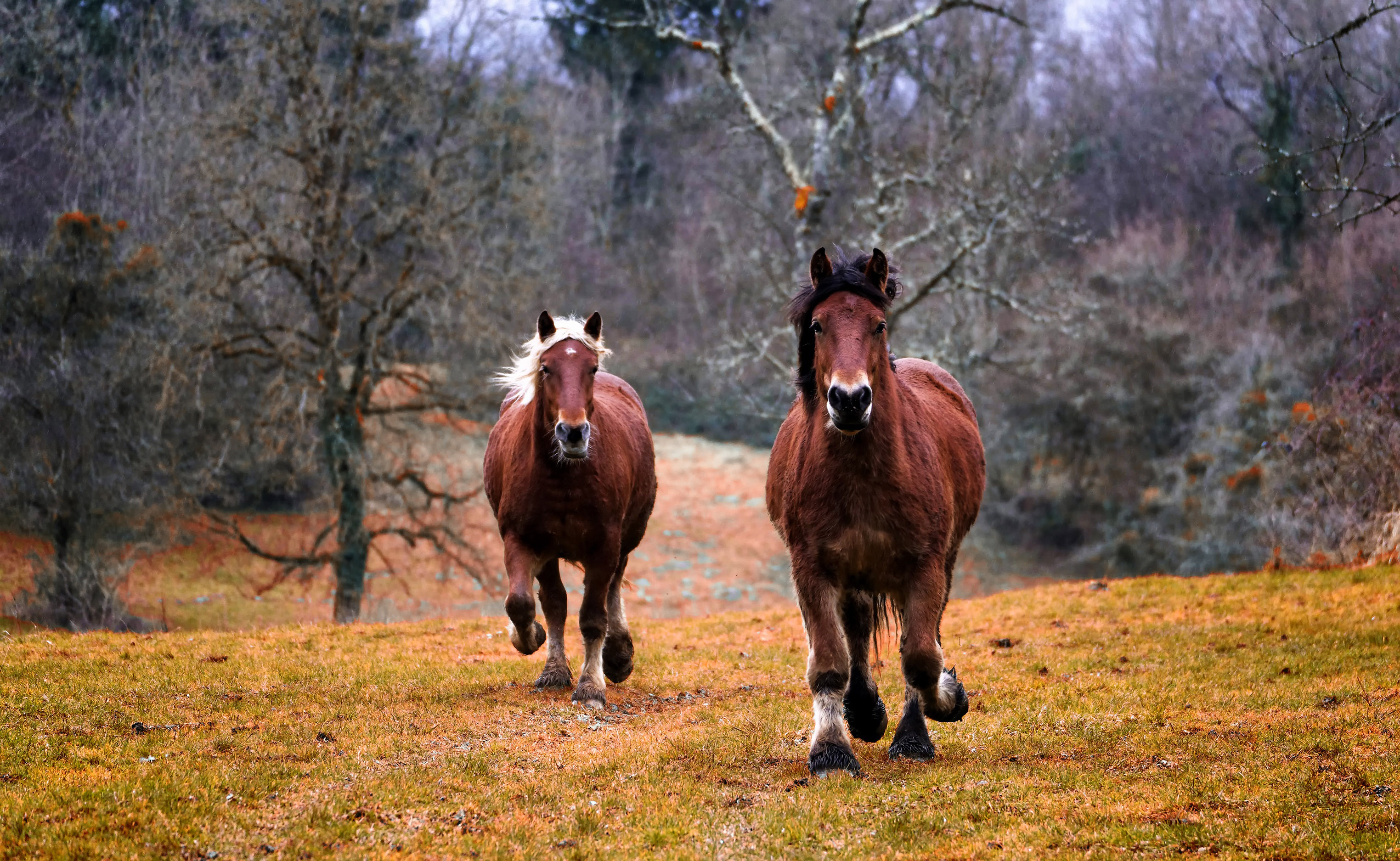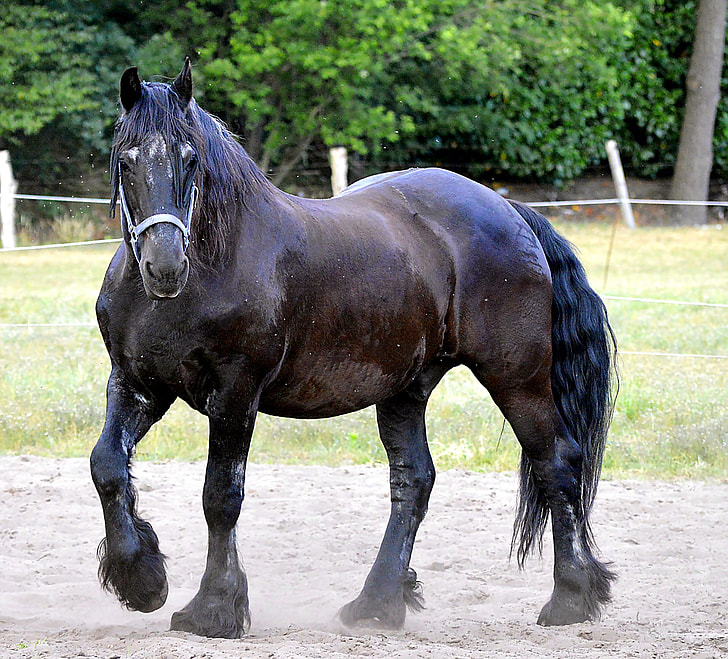
12 Stunningly Beautiful Horse Breeds
In MEXICO: The horse is a domesticated perissodactyl
mammal of the family of equidae. It is a large soliped herbivore with a long,
arched neck, populated by long mane.
The female
of the horse is called a mare and the calves, foals or foals if they are male,
and fillies or fillies if they are female. The breeding and use of the horse by
man, is known as equine or horse breeding, and its domestication dates back to
about 3,600 years BC in the region of Kazakhstan.
The Latin
term used to name the horse was equus, while caballus, which derived from the
word 'horse', is a Late Latin term, possibly of Celtic origin, meaning
'castrated horse'.
Currently
there are about 350 or 400 recognized horse breeds worldwide.
Friesian Horse:

The Friesian
(also called Friesian or Friesian) is a breed of horse originating from the
Friesland region of the Netherlands.
The mane of
the tail and neck are very thick and abundant, sometimes they may or may not be
both braided and somewhat wavy. From the head, we can say that it is quite long
and has small ears, which are always upright and elegant, characteristic of its
great docility and excellent temperament. As for the character, they are very
calm and have a lot of presence, making it a perfect animal for shooting (see
draft horse).
Akhal-Teke Horse:

.
The
Akhal-Teke horse is a breed of horse related to the extinct Turkmen horse
currently bred in Russia and Turkmenistan.
The Akhal-Teke
denomination derives from a geographical area, Akhal, and from a Turkmen ethnic
group, the Teke.
The
Akhal-Teke is a slender horse of approximately 1.60 m in males and 1.55 m in
mares. The overall appearance shows an elongated animal with a long, slender
neck, sometimes S-shaped, associated with a haughty port on the head.
The skin is
very fine and the coat is silky. The tail and the mane are rather scarce and
the bangs are almost absent.
The
Akhal-Teke breed is suitable for almost all equestrian disciplines, especially
endurance races and the full riding competition. He has also demonstrated good
aptitude in High School.
Trakehner Horses:

Race that
comes from ancient East Prussia. Initially developed by Frederick I of Prussia
as a military race, from World War II it would begin to breed mainly in the
western provinces of Germany. Currently, we can find it in America, New Zealand
and much of Europe.
The Current
Trakehner: Today, it is bred all over the world and there
are associations for the promotion and breeding of the breed in most countries,
reflecting its enormous popularity. The main origin book is controlled by the
Trakehner Association in Neumunster, Germany.
Percheron Horse:

The Percheron horse is an equine breed that originated in the province of Le Perche, near Normandy, in France. It is widely believed that the Arabian horse played an important role in the development of the Percheron. In the crusades, the Percheron Breed was widely recognized as excellent for its strength and integrity, as well as for its characteristic beauty and style. By the 17th century the horses produced in Le Perche, France had widespread notoriety.
In 1823, a horse named Jean le Blanc crossed a mare at Le Perche and all of Percheron's descendants go directly back to this horse.
Coat racks were first exported to the United States in 1839, by Edward Harris of Moorestown, New Jersey. The stallions, Normandy and Louis Napoleon, made it to Ohio in 1851. Louis Napoleon was later sold in Illinois and remained in the hands of the Dillon family who formed the Percheron Association.
Haflinger or Avelignese Horses:
The Haflinger or Avelignese breed is a breed of horse
developed in the late 19th century in Austria and Italy.
It is a small and robust horse very adapted to march
through the mountains.
The height can vary between 137 cm and 152 cm. The
coat is always palomino. The shade of the coat can be from relatively light to
darker shades. Some Haflingers display the characteristic or pangas pattern
(belly lighter in colour than the body).
All Haflingers come from the Folie stallion who was
the founder of the current breed. There are seven genealogical lines based on
seven seed horses descended from Folie (born 1874).
The origins of the current breed are remote. The 19th
century was greatly influenced by the Arab stallion El-Bédavo, father of Folie.
Tinker Horse:

Tinker horses have their origin in Ireland. From there
they are currently, and have been for a long time, indefatigable companions of
the gypsy communities of this country. What's more, its name in English means
gypsy.
These horses, thanks to their traits of docility and
strength, have been used throughout history as horses to pull carts or also for
riding. In addition, they have positioned themselves as one of the best horse
breeds to cover long distances carrying heavy loads.
Among the characteristics of these beautiful horses,
we find their strong and well-proportioned bodies of musculature. In addition
to this, these horses are of special beauty for the abundance of fur in areas
such as manes, tails, and also on their limbs.
Rocky Mountain Horses:

The Rocky Mountain Horse is a breed of horse from the Rocky Mountains of the United States of light colours like chocolate. Around the turn of the 20th century, a young horse, soon to be called the Rocky Mountain horse, appeared in eastern Kentucky that spawned a line of horses prized in North America and Europe. At Sam Tuttle's farm in Spout Springs Kentucky, there was an "Ancient Tobe" horse. Even though Ancient Tobe was a stud, he led the racers without hesitation. He fathered many good horses until the age of 37, and many of the Rocky Mountain horses present carry his bloodline.
Thoroughbred Arabian Horse:

The Arabian breed horse owes its reputation to its
intelligence, strong character and outstanding endurance. With a characteristic
head and tail always held high, it is one of the best recognized horse breeds
in the world.
In addition to the oldest, since there is
archaeological evidence of 4,500 years ago of horses very similar to modern
Arabs. In the course of history, the Arab horses of the Middle East spread
throughout the world thanks to trade and wars. They were also widely used to
improve other breeds by adding speed, refinement, endurance, and good bone
structure. Today, Arabian lines can be found in almost every modern breed of
horse to ride.
Norwegian Fjord Horse:

The colour of the Fjord, originally from Norway, and
the ancient haircuts are unique in the equine world. The Fjord has been played.
Appaloosa Horse:

Apalusa or Appaloosa is a horse coat bred, according
to the rules of an association founded in Idaho (United States) in 1938,
Appaloosa Horse Club. This association wanted to preserve the almost extinct
Nez Perce tribe horses.
An important aspect in the current Appaloosa is that
of their fur called "freckled" or "appaloosa" (in lowercase).
There are other breeds of horses with this "appaloosa" coat. In horse
some cases, as an exclusive colour and in others as an occasional or frequent
coat with other colours.
The Appaloosa is the breed that resulted from the
crossing of the Arabian horse with the Appaloosa horse.
Andalusia Horse:

The Andalusia horse (officially Pura Raza Española) is
a Spanish horse breed originating from Andalusia. It is a Baroque type Iberian
horse that is among the oldest equine breeds in the world. In Spain it is also
commonly known as "Spanish horse" and it is officially called
"Pure Spanish Breed" (PRE), because the Andalusia is considered to be
the Spanish horse par excellence, despite the fact that there are many other
Spanish equine breeds. However, in most countries, it is called the
"Andalusia horse". The Carthusian horse is one of the most important
breeding lines of this breed.
Lusitano Horse:
The Lusitanian horse is an equine breed of Portuguese origin whose name derives from Lusitania. It is an Iberian horse of the Baroque type, which until the 1960s shared a log book with the Andalusia horse.
Its height at the withers, it ranges from 150 to 160 cm, they are compact, with muscular hindquarters, strong and long legs, with great width in the step, inclined rump, low tail, wide chest, rounded ribs, broad forehead, Roman nose, mane and tail abundant. Lusitanian horses have a wide variety of solid colours, the least frequent and most sought after being palomino and cremello.
As with the Andalusia horse, its bravery, flexibility and nobility have traditionally stood out, making them suitable for riding, rejoin and dressage.
Comments
Post a Comment